(BFM Bourse) – The euro zone currency has recovered over the last three months by almost 9% against the dollar, thanks to a renewed appetite for market risk. But some research departments believe that the single currency could be subject to profit taking in the short term. But by the end of the year, the euro seems set to return to 1.10 dollars.
After being manhandled by the dollar king until the fall, the euro is taking its revenge. Over three months, the euro zone currency has recovered against the greenback, gaining more than 9%
. Compared to the low point reached in September, the currency of the monetary union even recovers almost 14%.
Several factors explain this increase. First of all, the market has regained an appetite for risk over the past few months, which has weighed on the dollar, considered a safe haven in the face of economic uncertainties. The European currency was also supported by the economic reopening of China, underlines Deutsche Bank, because the euro remains a “pro-cyclical” currency.
The European Central Bank has repeatedly shown firmness and determination to achieve its goal, namely to return to an inflation rate in the euro zone close to 2% – it stood at 9.2% on a year in December – within a horizon deemed “acceptable”. The latest economic indicators have also shown a marked improvement in the economic outlook in the euro zone. Recent PMI indices for January in the monetary union, for example, hit a seven-month high, raising hopes that the euro zone will escape recession this year.
Towards short-term consolidation?
“Given the collapse in gas prices, the euro’s terms of trade have completely unwound the 2022 deterioration and the end of winter will remove one last source of risk premium in European energy supply. “, also explains Deutsche Bank.
But hasn’t the market moved a bit too quickly? Beyond the euro, experts from the BlackRock Investment Institute consider that the market has shown “too hasty optimism”.
Bank of America considers for its part that the fall of the dollar is excessive, evoking an “over-reaction”. “Certainly the forces behind the dollar’s strong rise last year appear to have reversed: US inflation likely peaked, China moved quickly to reopen, and energy prices are lower. However, on each of those fronts, we don’t think we’re out of the woods yet.” [restrictive, NDLR] The Swiss bank UBS sees the euro “consolidating” against the dollar in the short term, that is to say undergoing profit taking in the “months to come” with “turbulence on the horizon”. The Swiss establishment considers that the Federal Reserve could surprise the market and cause it to push back the horizon on which it forecasts rate cuts by the American Federal Reserve. This would support the dollar against the euro. UBS also believes that the euro zone remains vulnerable to monetary tightening by the European Central Bank. “The European economy is, in our view, not yet strong enough to resist the hawkish trend
that some members of the ECB have promoted in recent weeks,” the bank said.
A euro above 1.2 dollars in 2024?
UBS thus sees the euro-dollar go back down to 1.05 at the end of March then go up to 1.07 at the end of June then at the end of September before however reaching 1.10 euro at the end of December. Bank of America, for its part, forecasts a similar development anticipating a rate of 1.05 at the end of March, then 1.05 at the end of June, 1.07 at the end of September and 1.10 at the end of December.
For their part Barclays and Deutsche Bank are more optimistic. The British bank sees the euro reaching 1.12 dollars at the end of the year, a forecast which it recently raised (it anticipated a rate of 1.05 dollars previously). Deutsche Bank considers that the euro could reach 1.10 dollars by the end of June and even 1.15 dollars by the end of the year.
Economist at the financial services company Atlantic Financial Group, Bruno Jacquier does not consider that the euro has rebounded too quickly against the dollar, judging the movement in line with, for example, the tightening of bond yield spreads on debt securities. two years between the euro zone and the United States.
“Our exchange rate target is 1.14 for the end of June, 1.23 for the end of the year, then 1.27 at the end of 2024, which would correspond to its equilibrium value in terms of power parity of purchase,” he explains.
The economist considers that the dollar will retain its status as a safe haven this year, “but this will not be enough for it to appreciate”.
“On the one hand because the fundamentals like the yield spread are no longer as buoyant and, on the other hand, because the United States will be under pressure to finance their debt this year”, he develops.
Price stopped Friday at the end of the Paris sessionJulien Marion – ©2023 BFM Bourse
Source link -84
